FlutterFlow and Bubble are well-known no-code development platforms that millions of people have used to build millions of apps. And while there are plenty of no-code builders to choose from, Bubble and FlutterFlow are two of the most popular options for a wide range of app types and industries.
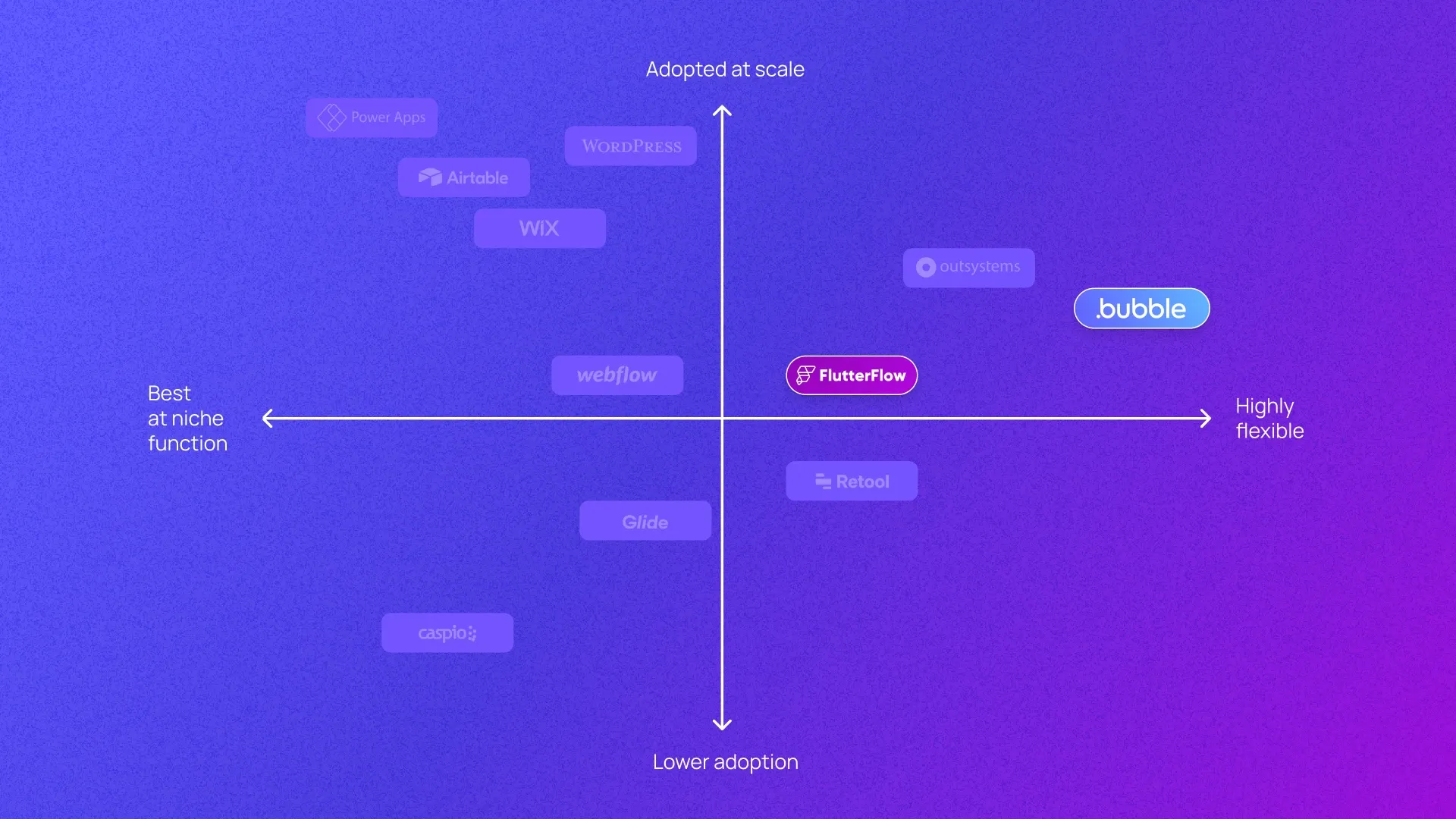
Both platforms enable you to build native mobile apps faster and more affordably than traditional app development (aka writing code), but Bubble has the edge when it comes to:
Of course, we are Bubble, and so naturally, we’re big fans of our own platform. That’s why we tapped the wider no-code community to find out what mattered most to them when choosing a platform. Then we used their responses to develop a rubric that more objectively compares Bubble to solutions like FlutterFlow.
As you compare these platforms for yourself, keep in mind that under the hood, FlutterFlow is built on Google’s proprietary coding language, Flutter. And there are two things you should know about Flutter:
- Google itself has prioritized a different programming language (Kotlin) for building Android apps and major Google apps. Maps, Home, Play, Drive, and Messages are built on Kotlin, not Flutter. They call it a “Kotlin-first” approach to Android development.
- The Flutter team was directly impacted by layoffs in the summer of 2024, and Google has declined to comment on how significantly the team was reduced.
Between the layoffs and Google’s stated Kotlin-first approach, Flutter developers have cautioned against building seriously on Flutter. Bubble, on the other hand, leverages React Native, a framework used and trusted by many of the world’s largest tech companies, including Meta, Microsoft, and Amazon.
In this article, we’ll show you how these two platforms stack up — and you’ll see why no matter what you’re trying to build, Bubble is your best option. If you want to learn more about the process of choosing the right tech for your use case, check out our full buyer’s guide to 23 different no-code development platforms.
FlutterFlow vs. Bubble: At-a-glance comparison
Let’s start with a high-level overview of how Bubble and FlutterFlow compare.
| FlutterFlow | Bubble | |
|---|---|---|
| Common use cases | FlutterFlow is a popular solution for quickly creating mobile app MVPs. | Bubble is one of the fastest ways to build custom, production-grade apps for web and mobile. |
| Where they shine | FlutterFlow is well-known for enabling developers to build mobile apps fast, even though some coding knowledge may be required. | Bubble accelerates speed to market and lets even non-technical founders build highly custom apps affordably. |
| Overall score | ⭐⭐⭐💫 (3.63) | ⭐⭐⭐⭐ (4.00) |
| Use-case versatility | 🟩🟩🟩🟩⬛ | 🟩🟩🟩🟩🟩 |
| Full-stack coverage | 🟩🟩🟩🟩⬛ | 🟩🟩🟩🟩🟩 |
| Performance | 🟨🟨🟨⬛⬛ | 🟩🟩🟩🟩⬛ |
| Ecosystem | 🟨🟨🟨⬛⬛ | 🟩🟩🟩🟩⬛ |
| Cost | 🟥🟥⬛⬛⬛ | 🟨🟨🟨⬛⬛ |
| Customizability | 🟨🟨🟨⬛⬛ | 🟩🟩🟩🟩⬛ |
| Compliance | 🟨🟨🟨⬛⬛ | 🟩🟩🟩🟩⬛ |
| Code ownership | 🟩🟩🟩🟩⬛ | 🟨🟨🟨⬛⬛ |
| Learning curve | 🟨🟨🟨⬛⬛ | 🟨🟨🟨⬛⬛ |
| Resources | 🟩🟩🟩🟩⬛ | 🟩🟩🟩🟩⬛ |
| Community | 🟩🟩🟩🟩🟩 | 🟩🟩🟩🟩🟩 |
We wanted to compare these platforms based on what matters most to actual no-code developers — so we asked them. In our 2024 State of No-Code Development survey, more than 350 no-code founders, developers, freelancers, and hobbyists rated the importance of 17 factors when choosing a no-code builder. We developed these categories using their feedback.
In the fall of 2024, we scored Bubble and Flutterflow from 1 to 5 in each of these categories, with 5 being the best score. Each score had specific requirements, and we’ll explain more about those below.
We also gave each platform an overall score using a weighted average. This was based on how important the category was to no-code developers in the survey. Here’s how Bubble and Flutterflow compared.
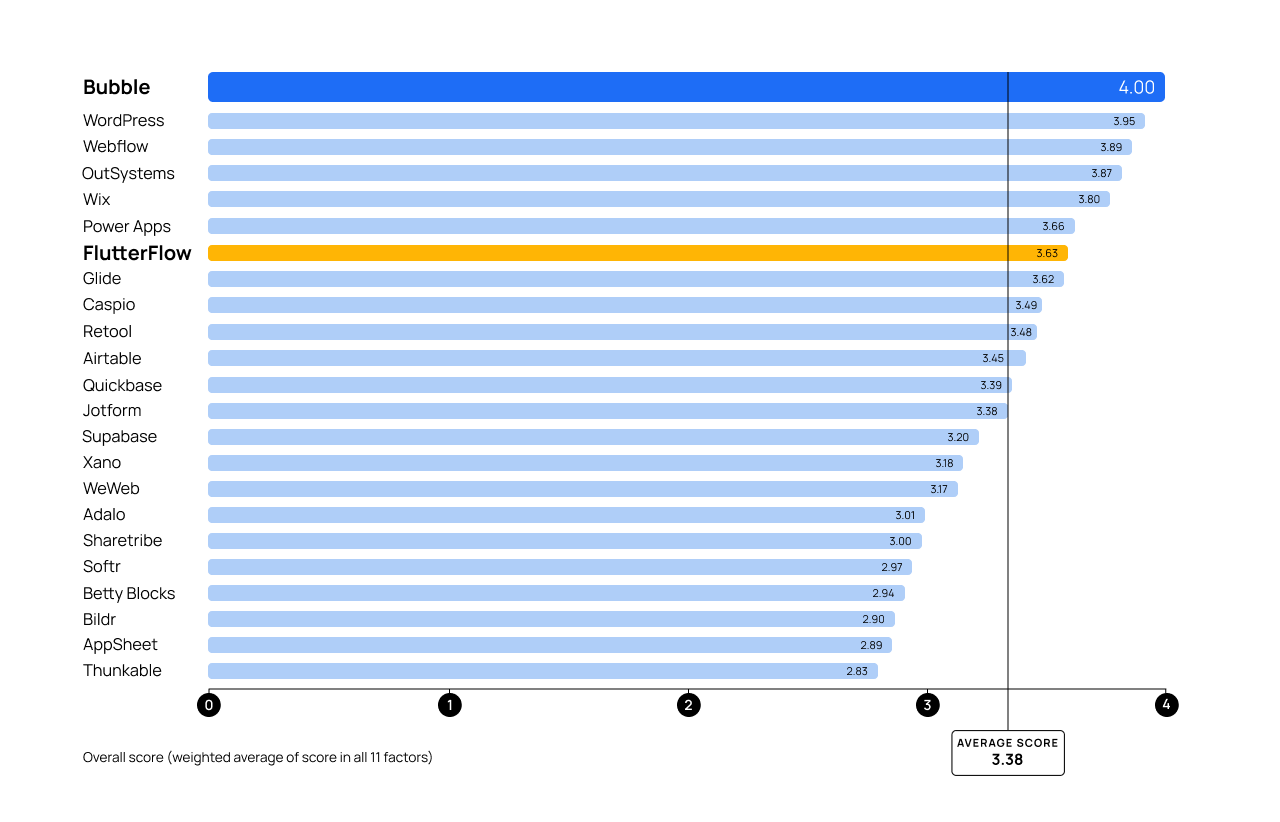
Flutterflow vs. Bubble on use-case versatility
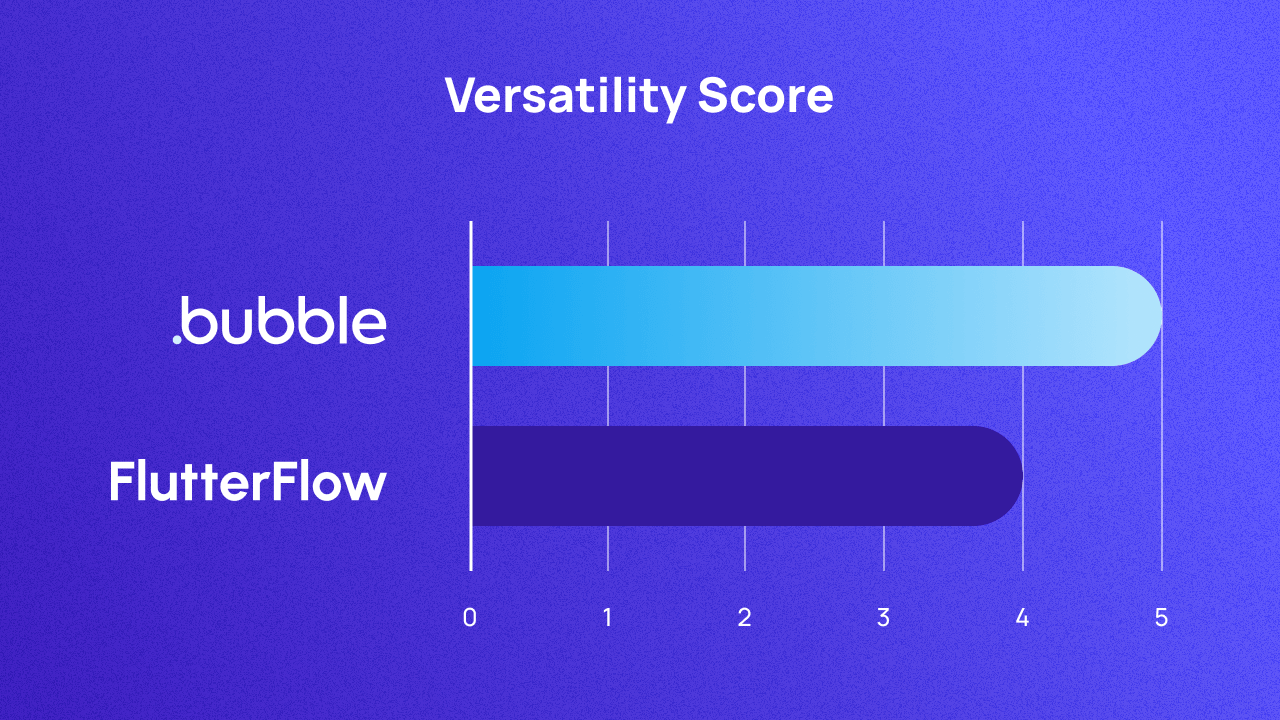
When people mostly use a platform to build specific types of apps — online stores, social apps, or business tools, for example — the platform’s parent company is likely to focus on new features and support for those use cases. This can also happen when a single industry adopts a platform: The vendor focuses on that niche. Either of these situations can mean the platform is best for particular use cases, even if it theoretically could be used for others.
So it helps to think about how most people actually use the platforms you’re comparing.
Our scores for use-case versatility try to take this into account, rating each platform based on the range of use cases most people use them for.
| Score | Criteria |
|---|---|
| 1 | Not particularly well-known or well-perceived by the market for any use cases |
| 2 | Narrow set of use cases as perceived by the market |
| 3 | Use-case versatility across app types or industries, but not both. |
| 4 | Use-case versatility across either app types or industries, with some use-case versatility in the other category |
| 5 | Shown to be proficiently versatile across both app types and industries |
How FlutterFlow stacks up: FlutterFlow users have built a variety of native mobile apps and web apps. While some have said it’s hard to build complex mobile apps that meet Apple’s standards, it’s certainly doable. Non-technical users can build basic mobile apps, but experienced developers often say they use FlutterFlow as a sort of “scratch pad” for quickly building MVPs and validating ideas.
FlutterFlow's versatility score: 4/5
How Bubble compares: People use Bubble to build all kinds of full-stack apps. With nearly 5 million apps created on Bubble, you’ll find a ton of use cases, from specialized industry-specific apps and internal tools to social apps, marketplaces, websites, one-off landing pages, and more. Bubble can be a frontend only solution, a backend only solution, or a full-stack solution. You have the flexibility to build different kinds of software in a wide range of industries, and it shows in the kinds of products our users create.
Bubble’s versatility score: 5/5
FlutterFlow vs. Bubble on full-stack coverage
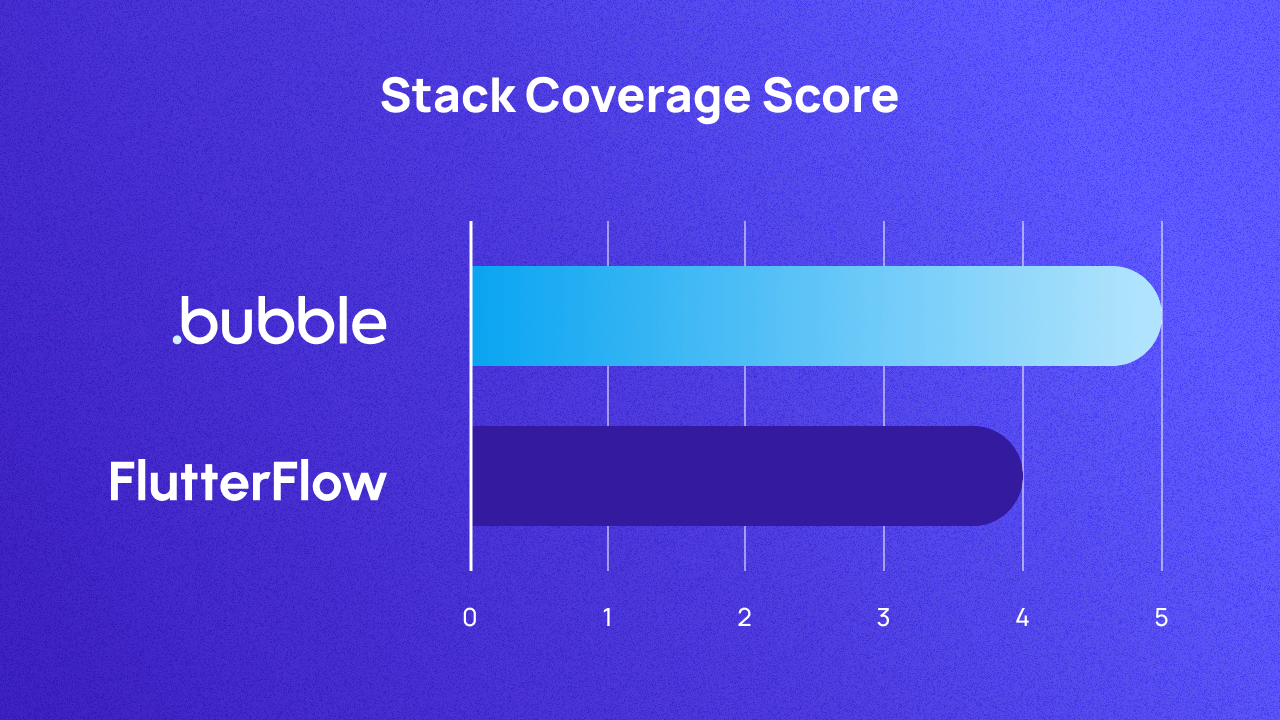
A full-stack no-code solution gives you complete control over all three aspects of software development: design, data, and logic. But many no-code platforms only focus on one or two of these areas, and they can’t give you access to the entire stack.Our scoring criteria for this category focuses on how much of the development process the platform lets users access — in other words, how close the platform is to being a “full-stack” solution.
| Score | Criteria |
|---|---|
| 1 | Capabilities in one area: design, data, or logic |
| 2 | Capabilities in one area, gives user limited access to another |
| 3 | Capabilities in two areas |
| 4 | Capabilities in two areas, gives user limited access to the third |
| 5 | Full-stack: Capabilities in design, data, and logic |
How FlutterFlow stacks up: FlutterFlow specializes in design and logic, and most users pair it with another backend. That said, FlutterFlow does let you create data schema, so if you use a schema-less backend like MongoDB, FlutterFlow can make that easier to work with. But it’s still not quite full-stack. You can create custom data types and define and organize your data fields, but the frontend and backend require different tools.
Also, when you use FlutterFlow, you also need to buy and integrate a separate backend to handle your data. This can make FlutterFlow's pricing plans confusing — or even misleading. The integration between Flutterflow and backends like Firebase and Supabase are pretty seamless, but since you need add-ons to use it, Flutterflow isn’t a perfect full-stack solution. It’s also part of the reason why many developers use Flutterflow to quickly produce MVPs and test ideas, then deploy their projects elsewhere.
FlutterFlow's stack coverage score: 4/5
How Bubble compares: Bubble is one of the few full-stack no-code development platforms on the market. You never have to combine it with another solution to control your software’s design, data, and logic. You can fully customize the look, feel, and functionality of your app in a single tool. Bubble can fill in gaps in your development stack or become your all-in-one solution. But you aren’t required to manage separate platforms to build your app, and you only ever need to pay for one.
Bubble’s stack coverage score: 5/5
FlutterFlow vs. Bubble on performance

The no-code platform you choose is essentially the foundation of your software. If it’s unstable, so is your app. When comparing Bubble and FlutterFlow, we considered how the platform performs as you scale up server demand — can the platform grow with you, or does performance take a hit when your user base gets too big?
| Score | Criteria |
|---|---|
| 1 | Frequent outages |
| 2 | Outages scale with user growth and/or company has no status page |
| 3 | Infrequent outages, but communicated with limited transparency to the user or sporadic outages, but quickly and transparently addressed |
| 4 | Infrequent outages, with any that do occur quickly and transparently addressed |
| 5 | Rare outages |
How FlutterFlow stacks up: FlutterFlow doesn’t have service outages very often, but when they do, users have complained about the lack of communication and poor visibility into the issue. So you might go long periods without performance problems, but when they do come up, you’ll probably have trouble figuring out how long they’ll affect your app or what’s being done to address them.
FlutterFlow’s performance score: 3/5
How Bubble compares: At the time of this article’s publication, Bubble had a 99.94% uptime over the last 90 days. Bubble rarely experiences outages, especially ones that affect a large number of users. But if they do happen, our team does two things especially well:
- We detect and resolve the issue quickly to get you back online.
- We clearly communicate what’s happening and what we’re doing about it, so you’re never in the dark.
We know that our operations directly impact yours, so we heavily invest in our network infrastructure and react fast to unforeseen issues. If you’re experiencing an issue, start by check Bubble’s status page. You can also keep up to date on outages via @BubbleStatus on X and the forum.
Bubble’s performance score: 4/5
FlutterFlow vs. Bubble on ecosystem
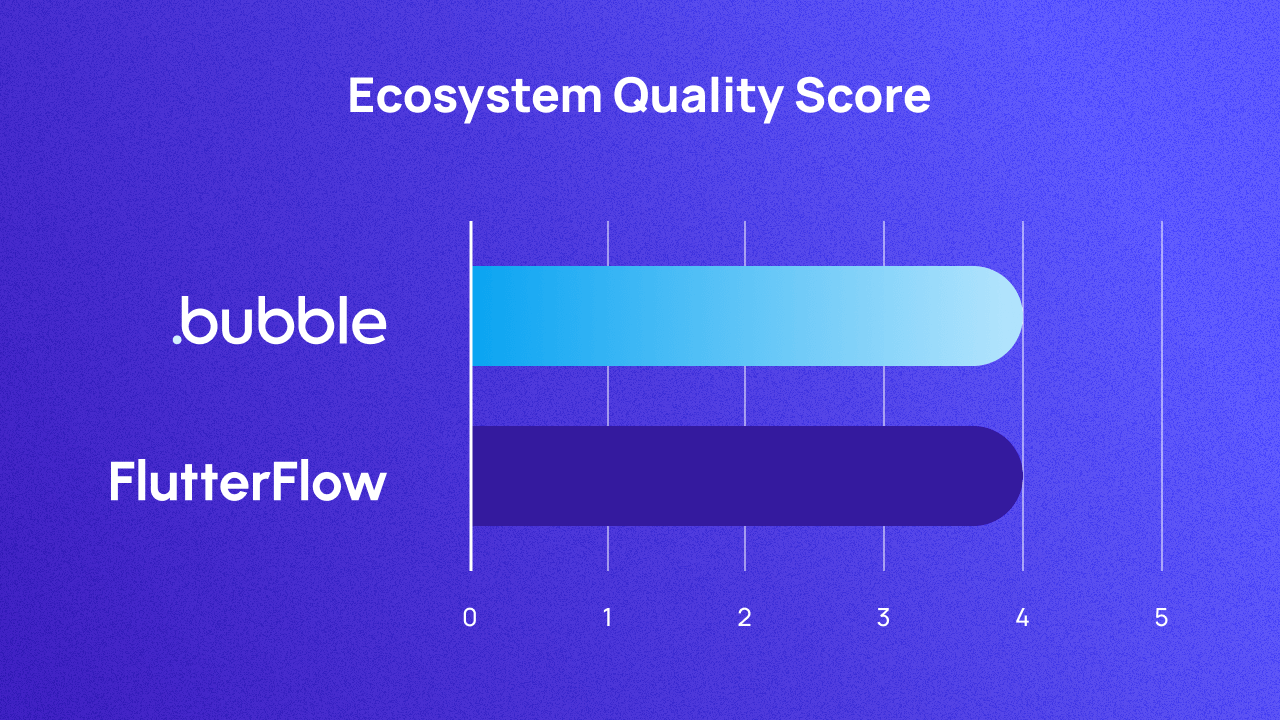
As you compare capabilities and vendors, it’s easy to forget: You’re not just picking a platform. Every platform has an ecosystem of third-party tools, services, partnerships, and extensions — and some are more useful and accessible than others.
Our ecosystem quality scores are based on what third-party services a vendor offers, the third-party products that have been created, how accessible they are, and what partnerships they have.
| Score | Criteria |
|---|---|
| 1 | Minimal third-party services that are challenging to use |
| 2 | Minimal third-party services, but they’re easier to use |
| 3 | Robust third-party services, but they’re challenging to use |
| 4 | Strong strategic partnerships; robust third-party services, but not perfectly seamless |
| 5 | Strong strategic partnerships; robust third-party services that are easy to use |
How FlutterFlow stacks up: FlutterFlow's marketplace makes it easy to find third-party templates, components, and custom code. But integrating them into your app often requires working with code. FlutterFlow's marketplace also shows plenty of agencies and freelancers who build apps for clients. But their website only filters by budget and “expert type.” Flutterflow also doesn’t have any strategic partnerships with startup programs or universities.
FlutterFlow’s ecosystem score: 3/5
How Bubble compares: Bubble’s ecosystem lets users build the features they want through thousands of plugins and templates. These third-party resources make it easy to connect your software with the other tools and services you need, without coding integrations yourself. (Although if you want and know how, it is possible to code your own plugins.) The Bubble community’s massive collection of templates also helps you build the pages, layouts, workflows, and designs you want even faster. And Bubble has strategic partnerships with startup programs including Microsoft For Startups and universities like Harvard and Columbia.Need to hire someone to build your app? Bubble’s agency database helps you filter and compare agencies that use Bubble by experience, services, cost, language, and region, so you can quickly find a partner that’s right for your project. You can even submit a request for proposal right on Bubble’s site.
Bubble’s ecosystem score: 4/5
FlutterFlow vs. Bubble on cost
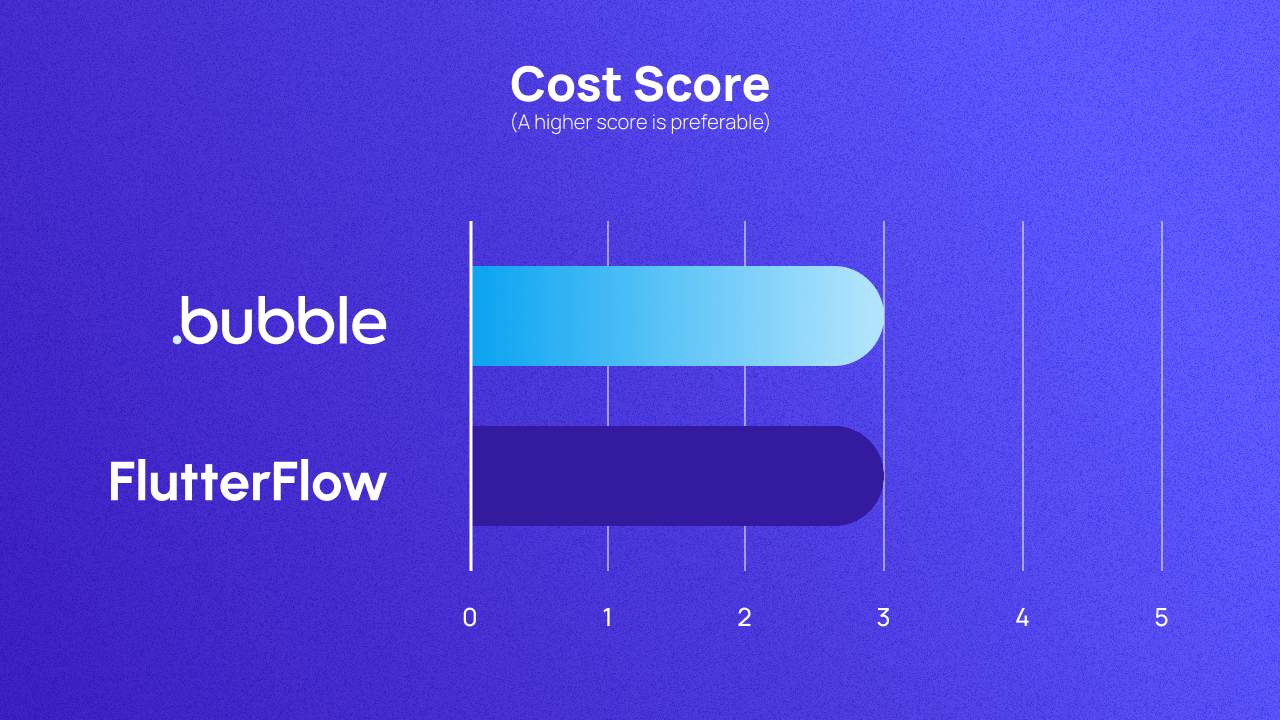
The cost grades we gave FlutterFlow and Bubble reflect the total cost of ownership, taking into account the pricing model and the platform’s monthly price, plus the cost in labor and workload of using the tool.
| Score | Criteria |
|---|---|
| 1 | No free tier |
| 2 | Free tier, deployment on custom domain costs more than $50 per month |
| 3 | Free tier, deployment on custom domain costs less than $50 per month |
| 4 | Free tier, deployment on custom domain costs less than $10 per month |
| 5 | Free deployment on custom domain |
How FlutterFlow stacks up: FlutterFlow has a free tier to get you started, and at a glance, their paid monthly plans look pretty reasonable. But in order to use Flutterflow, you also have to pay for a backend solution, and this monthly cost is usually based on your app usage. It’s confusing, and it can get expensive fast, too.
FlutterFlow's cost score: 3/5
How Bubble compares: Bubble offers a Free plan, which gives you all the access to the platform you need up until you deploy your app, aka take your software live. Paid monthly plans vary based on the workload demand of your software, the capabilities you need, and the number of people working on your app.
Put simply: Bubble servers have to scale with your app as it grows, and that means pricing does, too. Plans start at $29 a month.
Bubble’s cost score: 3/5
FlutterFlow vs. Bubble on customizability
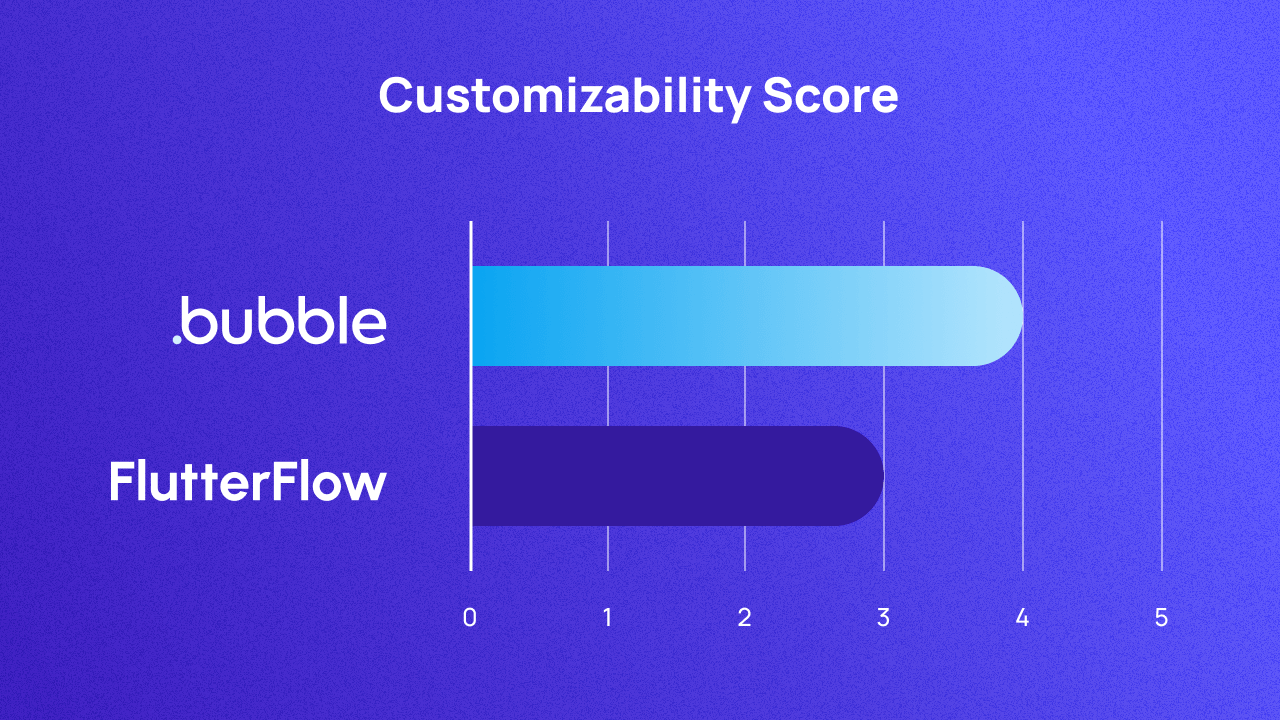
Every no-code platform offers some customization. But many platforms can only be fully customized if you use custom code — which kind of defeats the purpose of a no-code platform. If a platform says it’s no-code, it should let you create fully custom apps through its visual interface alone. The most accessible platforms go even further: They let you customize your app using AI, creating new components, features, and even complete apps through prompts.
In this comparison, our customizability scores are based on how flexible a platform is — both in terms of what you can build with it, and how easy it is to add new features throughout your software’s lifecycle. We also considered whether the platform makes customization easier with AI.
| Score | Criteria |
|---|---|
| 1 | Minimal ability to customize frontend, minimal ability to add new functionality, high level of difficulty to build beyond templates |
| 2 | Customizable frontend, minimal ability to add new functionality, limited generative AI assistance |
| 3 | Customizable frontend, open to adding new functionality, robust frontend AI use cases |
| 4 | Everything from 3, plus AI-generated logic and data schema |
| 5 | Everything from 4, plus conversational editing that allows for entire AI-generated apps |
How FlutterFlow stacks up: At first glance, FlutterFlow seems very customizable. But there’s a pretty big catch: Most of that customization requires custom code. As you start to move beyond its standard capabilities, Flutterflow basically becomes a low-code development platform. That won’t be an issue for more technical folks, but when it comes to no-code platforms, falling back on traditional programming languages should be an optional pathway to building what you want, not a required one.
FlutterFlow’s reliance on coding for customization means that non-technical users need to not only learn how to work within FlutterFlow's visual programming interface, but also learn how to code.
FlutterFlow’s customizability score: 3/5
How Bubble compares: Customization is an area where Bubble really shines. You can build just about anything, and you can add whatever capabilities you want, either within the Bubble editor itself or through our API Connector. With nearly 5 million apps created on Bubble, our users have built social platforms, marketplaces, KPI monitoring apps, apps that use generative AI, enterprise-level internal tools, and more. Think of an app — odds are you can build it on Bubble.
Plus, while you should never have to use custom code to add capabilities on Bubble, it’s always an option for those who want to.
Bubble’s customizability score: 5/5
FlutterFlow vs. Bubble on compliance
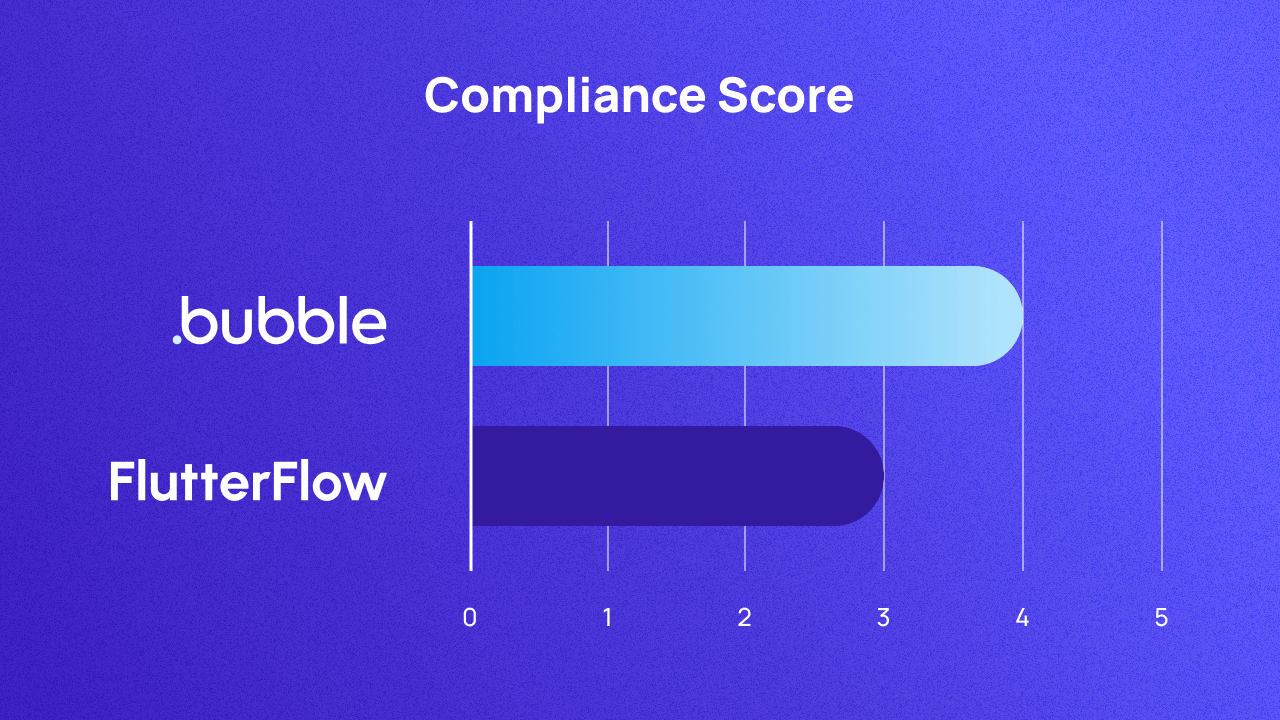
Your users trust you to keep their data secure. But you can only do that if you build your software on a secure development platform. Compliance standards help establish a baseline for security capabilities, and you can often harden a platform with additional security features as needed.
Our compliance scores are based on which standards a platform complies with (by default) and whether it offers a path to compliance with additional standards. Higher scores correspond to more sophisticated standards.
| Score | Criteria |
|---|---|
| 1 | No stated native compliance certifications |
| 2 | No native compliance certifications, but either 1) can be made compliant with plugins or 2) gives instructions for hosted apps to become compliant by themselves |
| 3 | SOC 2 Type I compliant |
| 4 | SOC 2 Type II compliant or ISO 27001 compliant |
| 5 | SOC 2 Type II compliant and HIPAA compliant |
How FlutterFlow stacks up: FlutterFlow is only compliant with SOC-2 Type I, which means their security processes haven’t passed a long-term audit yet — they just passed an audit at a specific point in time. If there are other specific regulations your app needs to comply with, you may be able to find an old forum post discussing how it works in FlutterFlow. That’s not great, but the FlutterFlow community is fairly active, so even if you’re the first to ask about a specific type of compliance, you can probably get insights from other users.
FlutterFlow’s compliance score: 3/5
How Bubble compares: Bubble has built-in compliance with SOC-2 Type II, which means it can pass long-term security audits. While we’ve implemented numerous solutions to help protect your data, there are some extra steps developers need to take to build software that complies with other frameworks like GDPR. We do, however, have a series of compliance articles that explain how to follow these standards when you build with Bubble. Plus, every Bubble pricing plan comes with access to some or all of Flusk’s best-in-class security-check features.
Bubble’s compliance score: 4/5
FlutterFlow vs. Bubble on code ownership
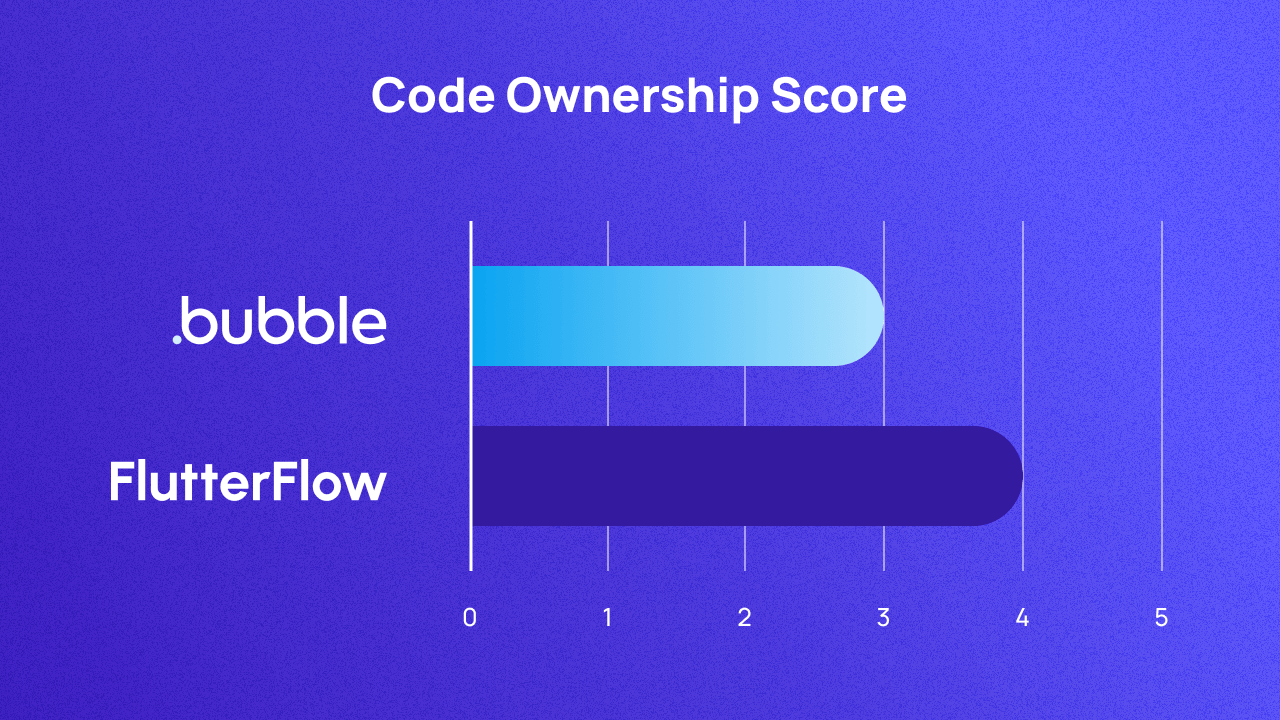
Maybe you’re only planning on using a no-code platform for short- or medium-term projects — just quickly testing and validating ideas. But even if you’re never planning to leave a no-code platform once you start building, it’s impossible to guarantee that you’ll never need to.
When choosing a no-code platform, it’s smart to go in knowing what you can take out. Our scoring criteria for the ownership category are based on how much freedom a platform gives you to export your work — specifically your code and your data.
| Score | Criteria |
|---|---|
| 1 | No exports supported |
| 2 | Allows partial data exports |
| 3 | Exports data, but not code |
| 4 | Exports data and code, but in limited languages and formats |
| 5 | Exports all data and code |
How FlutterFlow stacks up: FlutterFlow lets you export your code, but only as Dart code. And while FlutterFlow uses open-source packages to simplify code ownership, some users have said it’s hard to actually use this export process.
FlutterFlow’s code ownership score: 4/5
How Bubble compares: Bubble lets you export your data freely, but you can’t export your code. When you build in Bubble, our platform’s proprietary source code enables your software’s functionality, so we can’t export your code without either releasing our source code or separating it, which would break your software. Our promise to our customers, however, is that if your organization outlasts Bubble, we’ll release our source code under an open-source license.
Bubble’s code ownership score: 3/5
FlutterFlow vs. Bubble on learning curve
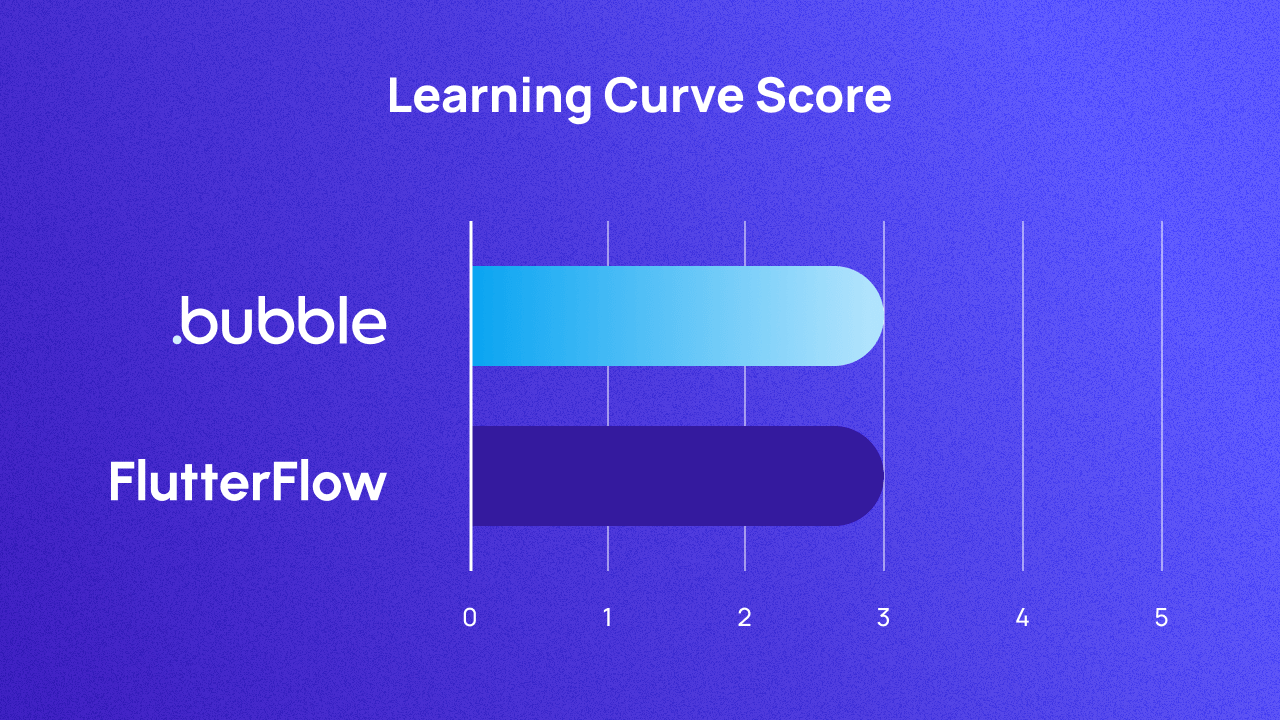
No-code development will always be easier than coding. But it still takes time. Every platform is going to use visual programming in different ways, and you’ll have to learn how to make the platform do what you want. Some require a more technical background than others. Some are so intuitive you’ll be ready to start building in as little as an hour. There will always be a learning curve, but it’s important to consider how steep of a curve you’re willing to take on.
In our State of No-Code Development survey, the expected learning curve was a crucial factor for experienced and novice developers alike. Just 2.5% of respondents said the learning curve was “not important at all,” while 22% said it was “extremely important.”
Our learning curve scoring criteria is based on how difficult a platform is to learn and how fast you can actually start building.
| Score | Criteria |
|---|---|
| 1 | Extremely difficult to learn (comparable to learning code), demands significant technical knowledge, extensive time investment |
| 2 | Very difficult to learn, demands strong understanding of logic and some technical familiarity, extensive time investment |
| 3 | Moderately difficult to learn, demands moderate technical familiarity, moderate time investment (courses, tutorials, community support, etc.) |
| 4 | Somewhat easy to learn, demands minimal technical familiarity, allows you to start building on your first day |
| 5 | Extremely easy to learn, no technical familiarity needed, allows you to build something in your first hour |
How FlutterFlow stacks up: FlutterFlow is simple at first, but as you progress through the basics, it gets challenging fast — especially for those with no previous coding experience. Building integrations and adding advanced capabilities to your app often requires coding, so it’s harder for non-technical professionals to pick up and start building with.
FlutterFlow's learning curve score: 3/5
How Bubble compares: Bubble is incredibly easy to get started with — especially if you start with the AI app generator. Describe the app you want to build in your own words and Bubble AI will create an overview of key features. Add, remove, or edit key features as much as you want, and generate when you’re ready. In moments, you’ll have a beautiful, responsive, and functional application that’s ready for you to iterate on. So even with no experience and just a basic idea, you can start building your very own app.
That said, managing and iterating your app on Bubble does take some time to learn fully (although it’s much quicker and easier than learning how to manage AI-generated custom code). We provide lots of resources and paths to learn, and our templates help you quickly turn straightforward ideas into fully-developed apps. A technical background helps you get more from the platform, faster, but you don’t need experience to hit the ground running. Many longtime users say simply spending time on Bubble has helped them learn technical concepts and become better developers.
Bubble’s learning curve score: 3/5
FlutterFlow vs. Bubble on education and documentation resources

You’re not going to know the ins and outs of a platform right from the start. And you shouldn’t have to have a background in design or development to benefit from visual programming. You want to be confident that the platform you choose has a place you can turn to for self-guided education and technical support when you run into challenges or need to do something new.
A free-response section of the State of No-Code Development 2024 survey asked respondents to share any additional considerations that were a key part of the tool comparison process. One out of every ten responses specifically referred to the importance of vetting the vendor’s educational resources. Our scores for a platform’s resources are based on how much first-party educational materials it has — like guides, tutorials, and technical documentation.
| Score | Criteria |
|---|---|
| 1 | Low-quality educational resources |
| 2 | Medium-quality resources |
| 3 | High-quality resources, low coverage |
| 4 | High-quality resources, medium coverage |
| 5 | High-quality resources, comprehensive coverage |
How FlutterFlow stacks up: FlutterFlow has a pretty comprehensive hub of educational materials in their documents section. It has everything you need to get familiar with the platform and important technical concepts, as well as guides to each step of building, publishing, and maintaining your app.
FlutterFlow’s education and documentation score: 4/5
How Bubble compares: Bubble has built a huge library of both high-level educational content and technical support documentation. We have hundreds of videos, numerous tutorial articles, a comprehensive online user manual, and a series of courses for getting started. Some vendors may have more topical coverage, but you’ll get plenty of quality resources with Bubble, and our Bubble Developer Certification program is an excellent way to become an expert in the platform.
Bubble’s education and documentation score: 4/5
FlutterFlow vs. Bubble on community
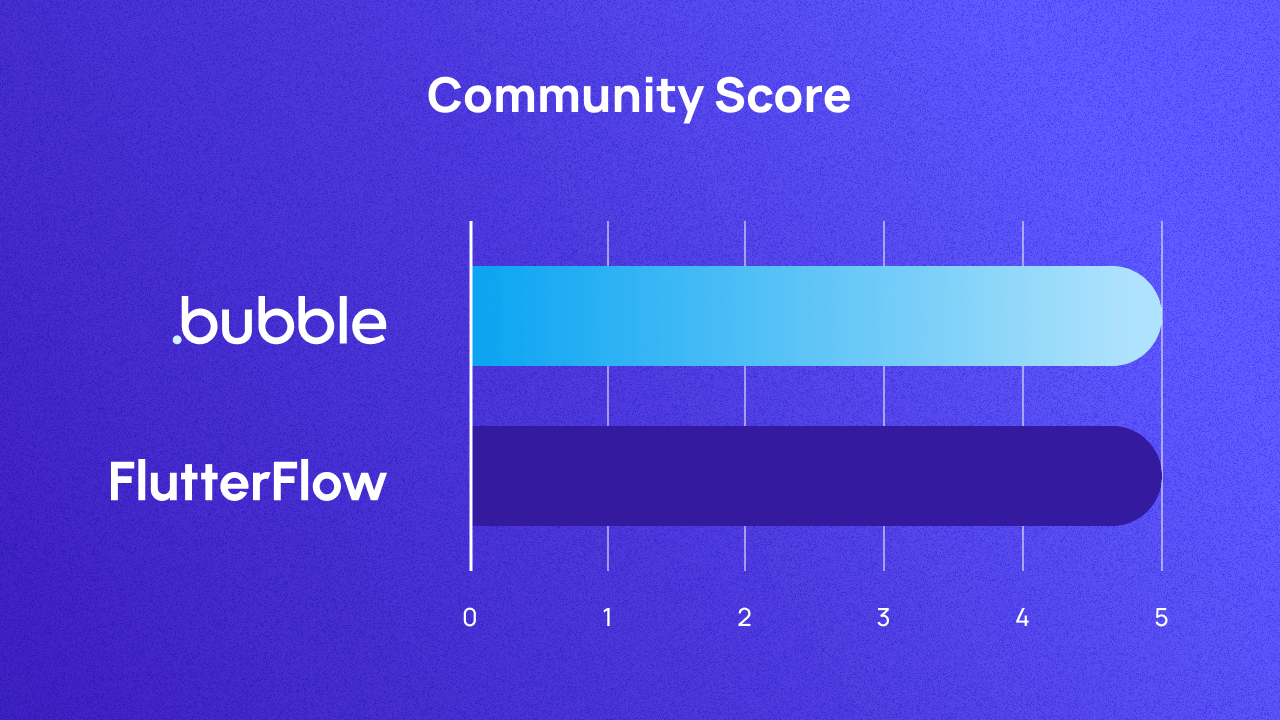
When you choose a no-code platform, you want to be confident that there will be a group of people who can help when you get stuck. The more people in that community, and the more active they are, the more likely you are to get the recommendations, tips, and feedback you need.
It’s also worth asking: Is the vendor part of that community? The more actively involved vendors are in the communities that form around their platforms, the more aware they are of users’ needs and sentiments — and the more access you have to the people who make decisions about the platform.
Our scores reflect how active a platform’s developer community is and the degree to which the platform vendor participates in the community.
| Score | Criteria |
|---|---|
| 1 | No community channels |
| 2 | Community channels exist, but participation is low |
| 3 | Active community, some company participation |
| 4 | Robust community, regular and valuable company participation |
| 5 | Everything in 4, plus in-person company events |
How FlutterFlow stacks up: FlutterFlow’s community is active on Reddit, Facebook, X, and the company’s community forums. FlutterFlow also hosts annual conferences in the US and Europe, as well as online events throughout the year. Whether you’re looking for help from like-minded individuals or hoping to share your work with others, you have multiple ways to find community and support.
FlutterFlow’s community score: 5/5
How Bubble compares: Bubble’s developer community is one of its greatest strengths. Not only does Bubble host a highly active forum where posts regularly see thousands of views and hundreds of comments, but Bubble users are also active on multiple subreddits, Discord groups, WhatsApp, Slack, Facebook, and more. We also host in-person events, which you can learn more about here. And when there are important announcements, we make sure to share them with our 100K followers on X and LinkedIn, too.
Bubble’s community score: 5/5
Bubble vs. FlutterFlow: Which one is for you?
Bubble and FlutterFlow are popular solutions for anyone looking to build apps without using code. With either option, you’ll find an active community of developers and plenty of first- and third-party resources to help you get started and walk you through the development process. But that’s where the similarities end.
FlutterFlow may appear to be a full-stack solution on paper, but its ability to generate data schema is only useful if you’re using a schema-less backend solution. And on its own, FlutterFlow doesn’t have the backend development capabilities you need. Bubble, on the other hand, is such a strong full-stack solution that no-code developers use it on its own, or to fill in design, data, or logic gaps in their existing software development stack.
When it comes to customization, Bubble has the clear edge: You can make whatever app you want without writing custom code. On Bubble, adding your own code is always optional, because our advanced visual programming is highly integrated with our broader ecosystem of third-party plugins, extensions, and templates, giving you the freedom to easily add and modify your software’s capabilities. FlutterFlow, however, requires coding to build more sophisticated custom apps, making it more of a low-code platform when you move beyond the basics.
With Bubble, you’ll also find greater transparency in a couple key areas: pricing and performance. Both platforms have usage-based pricing models, but as you scale with FlutterFlow, you’ll also have to pay for an additional platform for your backend. And while Bubble and FlutterFlow both only experience outages infrequently, you can expect a lot more upfront communication from Bubble. We know our performance directly impacts yours (or your clients’), so we keep you as informed as we can about what’s happening and what we’re doing about it.
Want to see how Bubble compares to other no-code platforms? Check out some of our other comparisons:
Choose the no-code development platform that’s right for you
The no-code platform you choose completely shapes what your products and tools can actually do, the speed with which you can bring them to market, the ongoing impact development has on your budget, and the experience you’ll have for years to come.
Want to learn more about what goes into choosing a no-code development platform, along with a more detailed breakdown of the choices available to you? Check out our buyer’s guide to no-code development platforms.
The best way to decide which no-code platform is right for you? Try them yourself. You’ll see the difference, especially if you start with these comparisons in mind.
Build for as long as you want on the Free plan. Only upgrade when you're ready to launch.
Join Bubble







